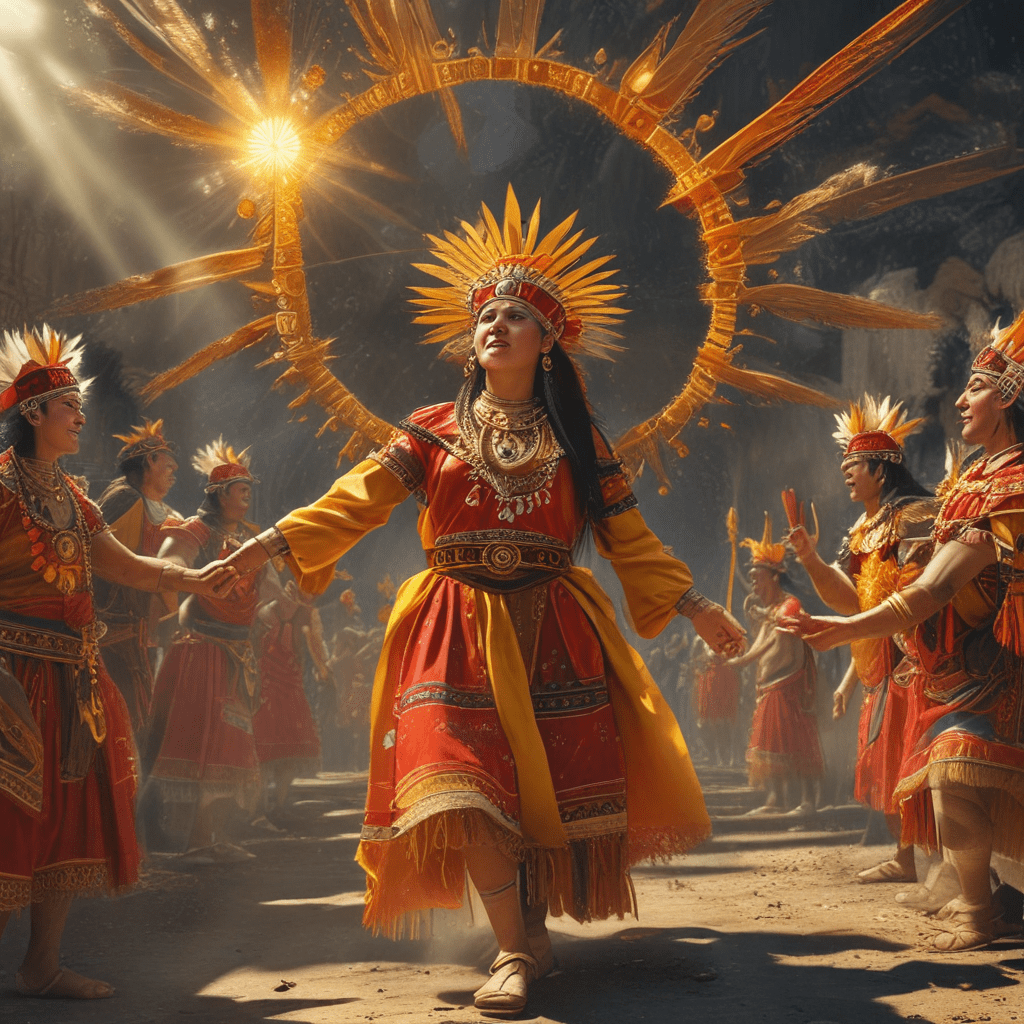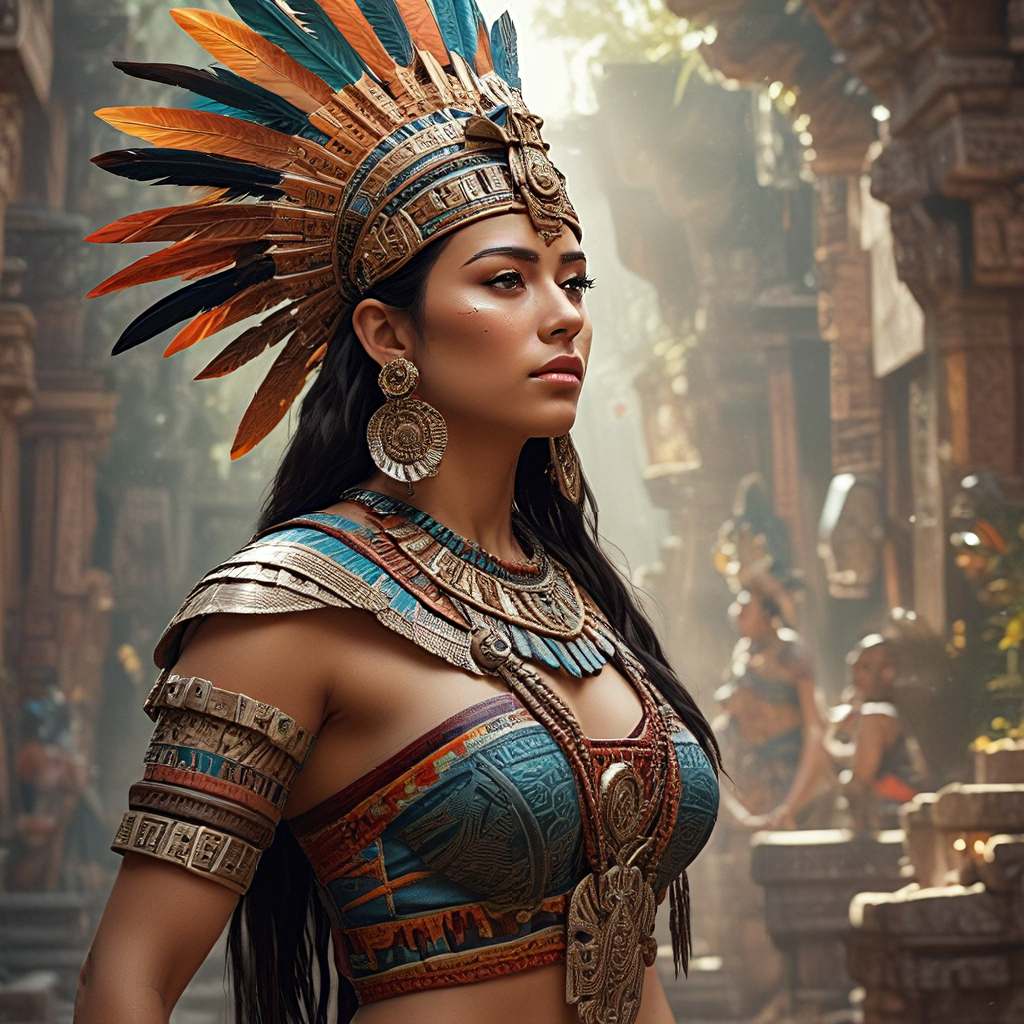The Mythological Significance of Inti
Inti, the Sun God, played a vital role in the mythology and religion of the Inca Empire. He was considered the most important deity, representing life, fertility, and the source of all energy. Inti was believed to be the son of Viracocha, the creator god, and his sister Mama Killa, the Moon Goddess. His name, "Inti," translates to "sun" in the Quechua language, the language spoken by the Inca people.
Incan mythology tells the story of Inti’s creation. Viracocha, the creator god, fashioned Inti from gold and gave him a golden staff and a golden chariot to ride across the sky. Inti was entrusted with the responsibility of bringing light and warmth to the Earth, ensuring the growth of crops and the survival of humans. His golden chariot was pulled by four white llamas, symbolizing his divine power and connection to the natural world.
Inti’s journey across the sky was believed to be a powerful event. As the sun rose in the east, it represented new beginnings and the promise of life. As it reached its zenith at noon, it was a time of maximum power and prosperity. And as it set in the west, it symbolized the end of a cycle and the promise of renewal. Inti's presence was seen as a constant reminder of the cycle of life, death, and rebirth. His influence extended beyond the physical world, shaping the Incan worldview and governing their daily lives.
The Role of the Sun God in Incan Religion
The Inca people deeply revered Inti, considering him the ultimate source of life and sustenance. His influence was evident in every aspect of their lives, from agriculture to politics to social rituals. The Inca believed that the sun's warmth was essential for the growth of their crops, allowing them to thrive in the Andean highlands. This connection to agriculture made Inti the patron god of farmers, and his blessings were sought during planting and harvesting seasons.
The Inca people offered sacrifices to Inti, seeking his favor in return for bountiful harvests and protection from natural disasters. These offerings could be anything from precious metals like gold and silver to food, animals, and even human sacrifices. These offerings were seen as a way to appease Inti and ensure his continued blessing upon the Inca Empire.
The Incan calendar, a complex system based on astronomical observations, was directly influenced by Inti. The year was divided into twelve lunar months, each marked by important religious ceremonies and festivals dedicated to Inti. These festivals celebrated different aspects of the sun's power, such as its ability to bring warmth, light, and fertility.
The sun god's influence wasn't limited to agriculture and the calendar; it also extended to the political sphere. The Inca emperors claimed descent from Inti, reinforcing their legitimacy and divine right to rule. This connection to the sun god gave them unparalleled authority and justified their control over the vast Inca Empire.
The Inti Raymi Festival: A Celebration of the Sun’s Power
The Inti Raymi festival, also known as the “Festival of the Sun,” was the most important religious celebration in the Incan Empire. Held annually on the winter solstice, it was a grand spectacle of worship, sacrifice, and celebration dedicated to Inti. The festival marked the beginning of the new year and the return of the sun's power after the shortest day of the year. It was a time for thanksgiving, renewal, and a celebration of the sun god’s vital role in Incan life.
The celebration was a week-long event filled with rituals, processions, and feasts. It brought together people from all corners of the empire, uniting them under the banner of worship to Inti. The main event, a grand ceremony held at the Temple of the Sun in Cusco, the Incan capital, was the highlight of the festival. The ceremony was presided over by the Inca emperor, who played a crucial role in the ritual offerings to Inti.
During the Inti Raymi festival, the Inca people expressed their gratitude to Inti for his blessings and sought his continued favor for the year ahead. The festival was a powerful expression of the Incan people's faith and their deep connection to the natural world, highlighting the importance of Inti in their lives.
The Preparations and Rituals of the Inti Raymi Festival
The Inti Raymi festival was meticulously planned and executed, requiring extensive preparations and meticulous attention to detail. Leading up to the festival, the Incan priests would consult the stars and perform divination rituals to determine the exact date of the winter solstice. Once the date was established, preparations began in earnest, ensuring a grand celebration worthy of the sun god.
The people of the Incan Empire, from the highest nobles to the common farmers, participated in the preparation, each contributing according to their role and status. Villages and towns were adorned with colorful banners and flowers, a vibrant display of their devotion to Inti. Special meals were prepared, reflecting the abundance of the land and the Incan people’s gratitude.
The climax of the Inti Raymi festival was the grand ceremony held at the Temple of the Sun in Cusco. Leading up to the ceremony, the Inca emperor, accompanied by his court, would travel to the Sacred Plaza, a central area in Cusco where the ceremony took place. Here, they would engage in a series of rituals, including purification and fasting, preparing themselves to receive the blessings of Inti.
The ceremony itself involved a complex series of rituals, each carefully choreographed and imbued with symbolism. The Inca emperor, adorned in ceremonial robes, would offer sacrifices to Inti, seeking his continued favor and protection. These sacrifices could include animals, precious metals, or, in some cases, human sacrifices.
The Ceremony and Offerings to Inti
The Inti Raymi festival's most important event was the grand ceremony held at the Temple of the Sun in Cusco. This momentous ceremony was a testament to the Inca people’s devotion to their solar deity. It involved a series of rituals and offerings, all meticulously planned and executed to ensure the sun god’s favor.
The Inca emperor, as the supreme ruler and the link between the divine and the human realms, played a central role in the ceremony. Dressed in ceremonial robes adorned with gold and precious stones, he would lead the rituals, offering prayers and sacrifices to Inti. The emperor was not just a political leader but also a religious figure, representing the entire Inca Empire in its devotion to the sun god.
The ceremony began with a procession, a grand display of Incan power and religious fervor. The Inca emperor, accompanied by his court, priests, and warriors, would walk from the Temple of the Sun to the Sacred Plaza, a large open space where the main ceremony took place. As they walked, they carried offerings of gold, silver, food, and animals, symbolizing the Inca people’s gratitude for Inti’s blessings.
The offerings made to Inti during the ceremony were carefully chosen to reflect their symbolic meaning. Gold, representing the sun’s warmth and brilliance, was a common offering, expressing the Inca people’s admiration for the sun god’s power. Food, particularly maize, was also offered, signifying the abundant harvests made possible by Inti’s light. Animal sacrifices, including llamas and alpacas, symbolized the Inca people’s willingness to give back to Inti, seeking his continued favor.
The Significance of the Inti Raymi Festival in Incan Society
The Inti Raymi festival was more than just a religious celebration; it held deep social and political significance for the Incan Empire. It served as a time for the diverse communities within the empire to come together, reinforcing their shared identity and loyalty to the Inca emperor. The festival was a powerful tool for maintaining social cohesion and reminding the Inca people of their shared cultural heritage.
The festival also served as a way for the Inca emperor to display his power and authority. By presiding over the ceremony and offering sacrifices to Inti, the emperor demonstrated his divine right to rule and his connection to the sun god. This reinforced his absolute power and legitimacy in the eyes of his people.
Furthermore, the grand scale of the festival and the participation of people from all corners of the empire emphasized the Inca emperor’s control over a vast and diverse territory. The Inti Raymi festival solidified the Inca emperor’s power, highlighting his role as the supreme leader and the embodiment of Incan culture and tradition.
Theories on the Origin and Evolution of the Inti Raymi Festival
The origins of the Inti Raymi festival are shrouded in mystery, lost in the mists of time. However, scholars have proposed numerous theories regarding its origins and evolution. Some believe that the festival's roots lie in ancient Andean agricultural practices, with celebrations marking the solstices and equinoxes, events that significantly influenced agricultural cycles. These early rituals, focusing on ensuring fertile harvests, may have evolved into the grand Inti Raymi festival we know today.
Other theories emphasize the festival’s connection to the Incan worship of the sun god, Inti. As the Inca empire grew and expanded, the Inti Raymi festival may have become a powerful tool to unify the diverse communities under the banner of a shared deity. The festival's increased scale and complexity may reflect the growing importance of Inti in Incan religion and the desire to create a grand spectacle worthy of the sun god’s power.
While the precise origins of the Inti Raymi festival remain debated, it is clear that the festival evolved over centuries, incorporating elements of pre-Incan traditions and rituals into a grand celebration that became a cornerstone of Incan civilization.
The Impact of the Spanish Conquest on the Inti Raymi Festival
The arrival of the Spanish conquistadors in the 16th century marked a turning point in the history of the Inti Raymi festival. The Spanish, driven by their desire to convert the Inca people to Christianity, saw the Inti Raymi festival as a symbol of paganism, something to be eradicated and replaced with Christian traditions. They actively suppressed the festival, banning the public celebration and persecuting those who continued to practice the ancient rituals.
The Spanish conquest effectively ended the open celebration of the Inti Raymi festival. The grand ceremonies, processions, and sacrifices fell silent, replaced by Christian rituals and celebrations. However, the Incan people, despite the suppression, continued to hold onto their traditions, observing the festival in secret, ensuring its survival in the face of Spanish oppression.
The Revival and Modern Celebration of Inti Raymi
After centuries of suppression, the Inti Raymi festival experienced a revival in the 20th century. This resurgence was driven by a renewed interest in Incan culture and a desire to reclaim a lost heritage. In 1944, the Inti Raymi festival was officially revived in Cusco, Peru, drawing inspiration from historical accounts and oral traditions passed down through generations.
The modern Inti Raymi festival is a grand spectacle, drawing thousands of tourists and locals alike to witness a vibrant celebration of Incan culture. The festival, held annually on June 24th, features elaborate costumes, traditional music and dance, and reenactments of ancient rituals, all paying tribute to the sun god Inti.
The revival of the Inti Raymi festival has been a testament to the resilience of Incan culture, demonstrating the enduring power of tradition and the importance of preserving cultural heritage.
The Enduring Legacy of the Inti Raymi Festival
The Inti Raymi festival, despite facing suppression and near extinction, has endured for centuries, leaving a lasting legacy on Incan culture and the world at large. The festival’s enduring power lies in its ability to connect the Incan people to their ancestors, their history, and their unique cultural heritage. The festival serves as a powerful reminder of the resilience of Incan culture, its ability to adapt and survive in the face of adversity.
The modern Inti Raymi festival, a blend of ancient tradition and contemporary adaptation, continues to attract visitors from around the world, eager to witness a vibrant celebration of Incan culture. The festival serves as a bridge between the past and the present, allowing people to experience the splendor of Incan traditions and to engage with the rich history and mythology that shaped the Incan civilization.
The Inti Raymi festival, a testament to the enduring power of tradition, reminds us of the importance of preserving cultural heritage and celebrating the unique stories that connect us to our past.
FAQ
Q: What is the Inti Raymi festival?
A: The Inti Raymi festival is a traditional Incan festival celebrating the sun god, Inti. It was held annually on the winter solstice and involved elaborate rituals, processions, and offerings.
Q: What was the significance of the Inti Raymi festival?
A: The Inti Raymi festival was a major religious celebration, a time for thanksgiving to Inti, seeking his favor for the year ahead. It also held social and political significance, reinforcing the Inca emperor’s power and unifying the Inca people.
Q: What happened to the Inti Raymi festival after the Spanish conquest?
A: The Spanish, driven by their desire to convert the Incan people to Christianity, suppressed the Inti Raymi festival. They banned the public celebration and persecuted those who continued to practice the ancient rituals.
Q: When was the Inti Raymi festival revived?
A: The Inti Raymi festival was officially revived in Cusco, Peru, in 1944.
Q: What is the modern Inti Raymi festival like?
A: The modern Inti Raymi festival is a grand spectacle, featuring elaborate costumes, traditional music and dance, and reenactments of ancient rituals, all paying tribute to the sun god Inti.


